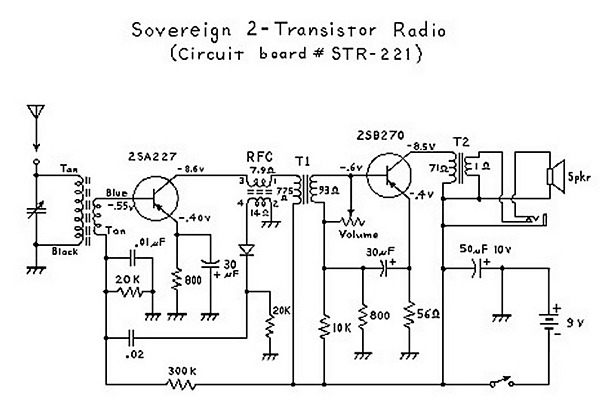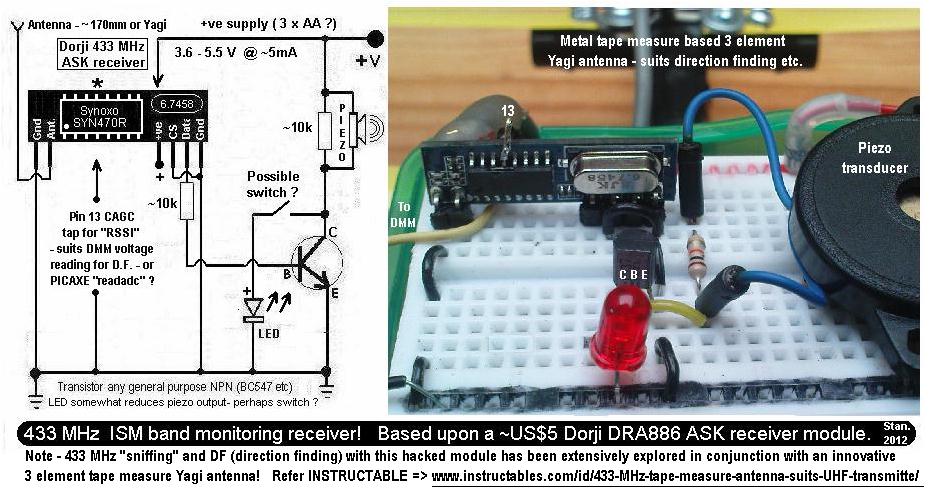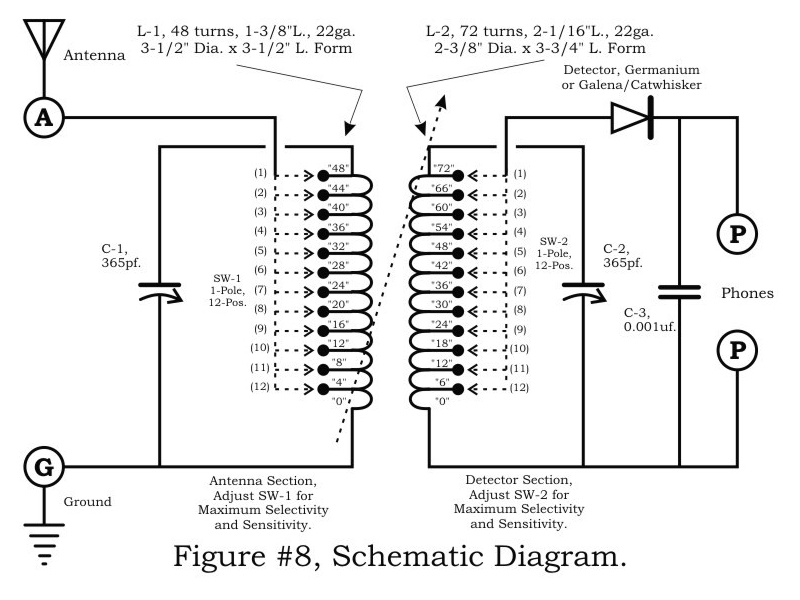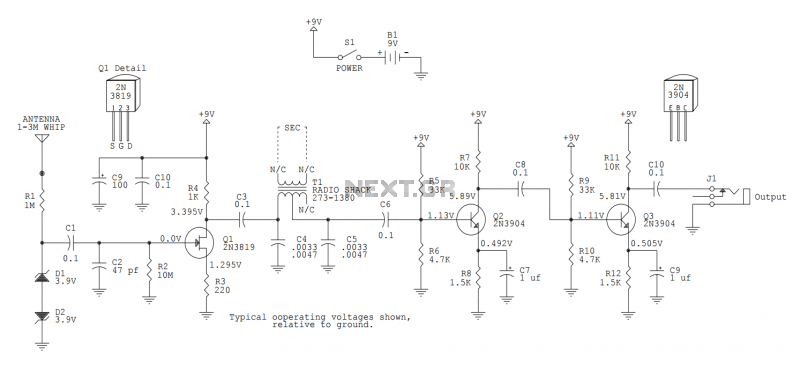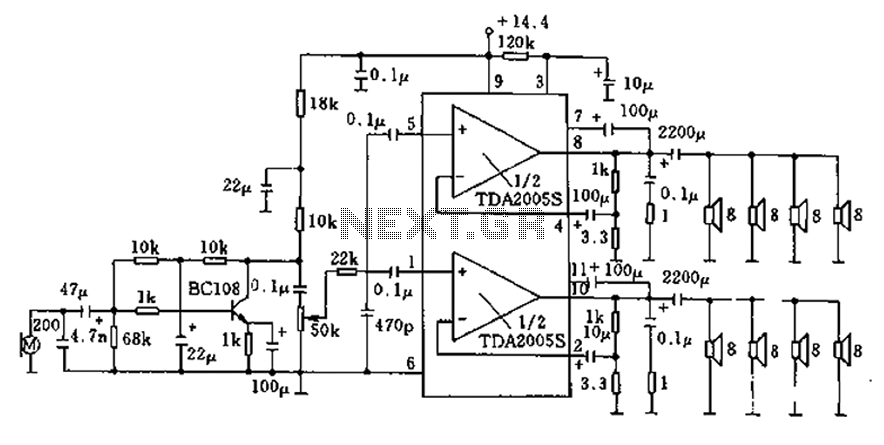
Radio Circuits
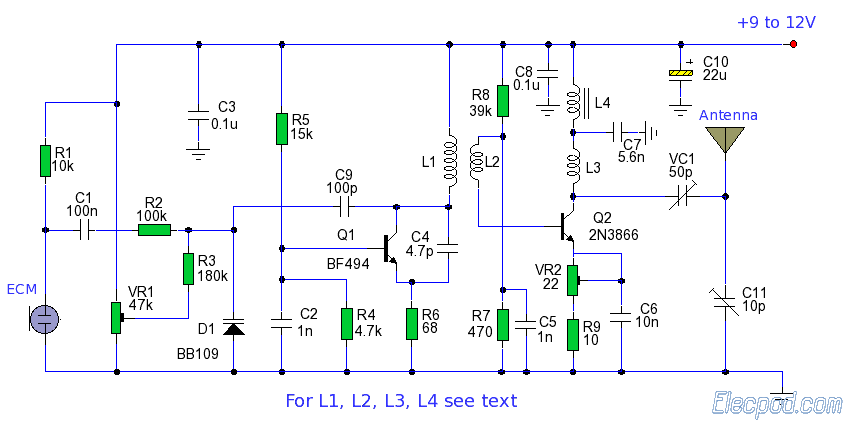
The ZN414 is an economical, single-chip AM radio integrated circuit introduced in 1972 by Ferranti. The TDA7000 is a monolithic integrated circuit designed for mono FM portable radios or receivers, focusing on minimizing size. Additionally, there is an FM spy transmitter that can function as a bug transmitter or a DIY FM bug transmitter. This RF detector is capable of responding to RF signals below the standard broadcast band and extending to well over 500 MHz, providing a visual indication. It is designed to amplify low-power 2.4 GHz pinhole cameras, which typically have limited power and range. The described transmitter circuit includes an additional RF power amplifier stage following the oscillator stage, increasing the power output to 200-250 milliwatts.
The ZN414 integrated circuit is notable for its simplicity and cost-effectiveness, making it an ideal choice for hobbyists and low-budget AM radio applications. It features a few external components, which facilitate the tuning and operation of AM radio frequencies. The circuit operates efficiently within the AM band, allowing users to receive local broadcasts with minimal interference and high clarity.
The TDA7000, on the other hand, is optimized for FM radio applications and is characterized by its compact design, making it suitable for portable devices. This IC integrates all necessary functions for FM reception, including a frequency synthesizer, demodulator, and audio amplifier, which simplifies the design of FM receivers. Its low power consumption is particularly advantageous for battery-operated devices.
The FM spy transmitter mentioned is an intriguing application of RF technology. It can be utilized for covert audio transmission, with its design allowing for discreet placement and operation. The additional RF power amplifier stage in the transmitter circuit significantly enhances its range and signal strength, making it capable of transmitting over longer distances without compromising audio quality. This feature is particularly useful in scenarios where the transmitter needs to overcome obstacles or interference.
The RF detector described is a versatile component that can be employed in various applications, including signal strength monitoring and frequency identification. Its ability to detect signals across a wide frequency range makes it suitable for both amateur radio enthusiasts and professionals in the field of RF engineering. The visual output provided by the detector allows users to easily ascertain the presence and strength of RF signals, aiding in the troubleshooting and optimization of RF systems.
Overall, these components collectively showcase the advancements in RF and audio technology since their introduction, providing a foundation for both simple and complex electronic projects. Their integration into various applications highlights the ongoing relevance and utility of these integrated circuits in modern electronics.The ZN414 is a low cost, single-chip AM radio integrated circuit. Launched in 1972, the part was designed and supplied by Ferranti. Receiver CircuitThe TDA7000 is a monolithic integrated circuit for mono FM portable radios or receivers where a minimum. Take a look at this fm spy transmitter which can be used as a bug transmitter or as diy fm bug t oo. This rf detector responds to RF signals bellow the standard broadcast band to well over 500 MHz and provides an visual. They are designed to amplify those flimsy 2. 4 GHz Pinhole cameras with such annoyingly low power and short range. The transmitter circuit described here has an extra RF power amplifier stage, after the oscillator stage, to raise the power output to 200-250 milliwatts.
🔗 External reference
The ZN414 integrated circuit is notable for its simplicity and cost-effectiveness, making it an ideal choice for hobbyists and low-budget AM radio applications. It features a few external components, which facilitate the tuning and operation of AM radio frequencies. The circuit operates efficiently within the AM band, allowing users to receive local broadcasts with minimal interference and high clarity.
The TDA7000, on the other hand, is optimized for FM radio applications and is characterized by its compact design, making it suitable for portable devices. This IC integrates all necessary functions for FM reception, including a frequency synthesizer, demodulator, and audio amplifier, which simplifies the design of FM receivers. Its low power consumption is particularly advantageous for battery-operated devices.
The FM spy transmitter mentioned is an intriguing application of RF technology. It can be utilized for covert audio transmission, with its design allowing for discreet placement and operation. The additional RF power amplifier stage in the transmitter circuit significantly enhances its range and signal strength, making it capable of transmitting over longer distances without compromising audio quality. This feature is particularly useful in scenarios where the transmitter needs to overcome obstacles or interference.
The RF detector described is a versatile component that can be employed in various applications, including signal strength monitoring and frequency identification. Its ability to detect signals across a wide frequency range makes it suitable for both amateur radio enthusiasts and professionals in the field of RF engineering. The visual output provided by the detector allows users to easily ascertain the presence and strength of RF signals, aiding in the troubleshooting and optimization of RF systems.
Overall, these components collectively showcase the advancements in RF and audio technology since their introduction, providing a foundation for both simple and complex electronic projects. Their integration into various applications highlights the ongoing relevance and utility of these integrated circuits in modern electronics.The ZN414 is a low cost, single-chip AM radio integrated circuit. Launched in 1972, the part was designed and supplied by Ferranti. Receiver CircuitThe TDA7000 is a monolithic integrated circuit for mono FM portable radios or receivers where a minimum. Take a look at this fm spy transmitter which can be used as a bug transmitter or as diy fm bug t oo. This rf detector responds to RF signals bellow the standard broadcast band to well over 500 MHz and provides an visual. They are designed to amplify those flimsy 2. 4 GHz Pinhole cameras with such annoyingly low power and short range. The transmitter circuit described here has an extra RF power amplifier stage, after the oscillator stage, to raise the power output to 200-250 milliwatts.
🔗 External reference
